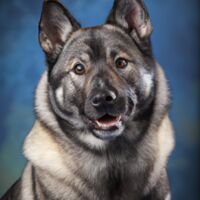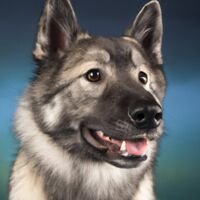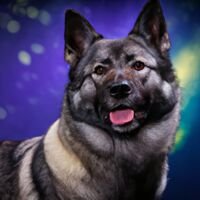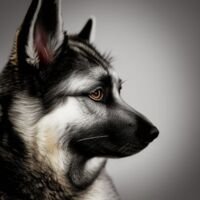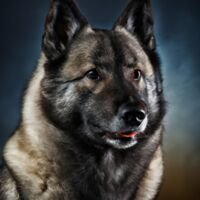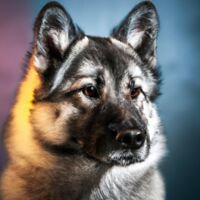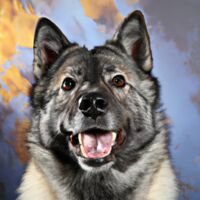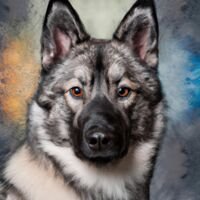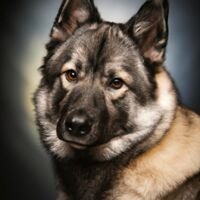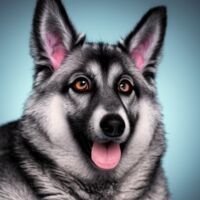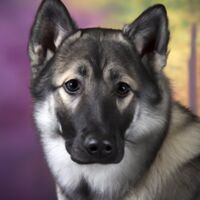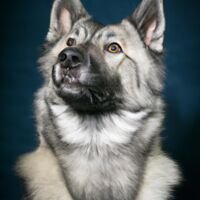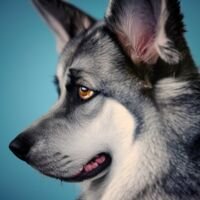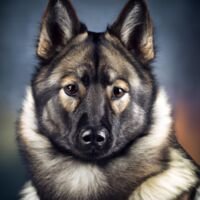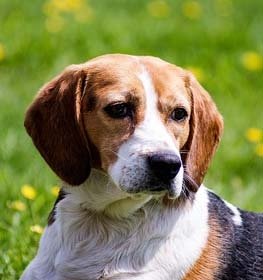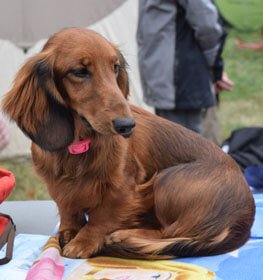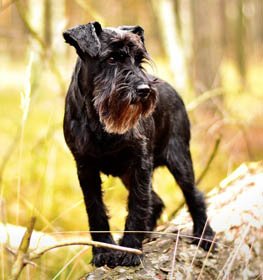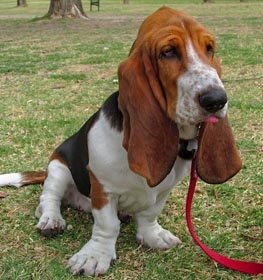Norwegian Elkhound Information & Dog Breed Facts
Collection of all the general dog breed info about Norwegian Elkhound so you can get to know the breed more.
| Group | Hunting Dogs |
|---|---|
| Popularity Rank | 91 |
| Reviews | 2 |
| User Ratings | |
|
Compare the Norwegian Elkhound With Other Dogs
Select at least one dog breed to make the comparsion. | |
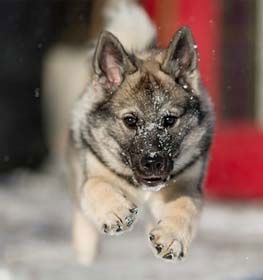 | |
| Origin | |
|
Common Names & Aliases
What other names is a Norwegian Elkhound known by? Discover all traditional, regional and informal names used for this breed. | Gra Norsk ElghundGray Norwegian ElkhoundHarmaa NorjanhirvikoiraNorsk ElghundNorwegian Moose DogSmall Grey Elk DogElkhound |
|---|---|
|
Breed Classification
What type of dog breed is a Norwegian Elkhound? Learn about its genetic classification and breeding category. | Purebred |
Photo Gallery of the Norwegian Elkhound Breed
|
Size Classification
What size category is a Norwegian Elkhound? Learn how big the Norwegian Elkhound breed typically grows. | Large |
|---|---|
|
Weight Statistics
How much does a Norwegian Elkhound weigh? Discover typical weight ranges for adult males and females of the Norwegian Elkhound breed. | Male: 50-60 pounds (23-27 kg), Female: 40-55 pounds (18-25 kg) |
|
Average Weight
What is the average weight of a Norwegian Elkhound? | Male: 55 pounds (25 kg), Female: 47.5 pounds (21.5 kg) |
|
Height
How tall is the Norwegian Elkhound? Norwegian Elkhound height: | Male: 19-21 inches (48-53 cm), Female: 18-20 inches (46-51 cm) |
|
Average Height
What is the average height of a Norwegian Elkhound? | Male: 20 inches (50.5 cm), Female: 19 inches (48.5 cm) |
|
Price Range
How much does a Norwegian Elkhound puppy cost? Find current market prices and factors affecting Norwegian Elkhound costs. | $500-$700 If you choose to purchase the Norwegian Elkhound, you should know that the mentioned amount of money is an average of the collected data from breeders’ sites and puppy finder places. If you have a Norwegian Elkhound for sale, please advertise it on a reliable website to make sure the Norwegian Elkhound gets to a happy place. |
|---|---|
|
Availability
How easy is it to get a Norwegian Elkhound? How many Norwegian Elkhound are there in the world? | Very frequent: The Norwegian Elkhound is quite easy to get. There is a risk of overbreeding, as it is an extremely popular breed. Inbreeding is common because of its popularity. A new study suggests that inbreeding contributes to the incidence of disease and health problems. So be careful, buy from a trustworthy place or kennel and seek the help of an experienced person, a professional, to make the right decision. |
|
Intelligence Rating
How intelligent is a Norwegian Elkhound? Discover the Norwegian Elkhound's intelligence ranking and learning capabilities. | Smart: The Norwegian Elkhound dogs have great intelligence. They understand and memorize new commands in 15-25 repetitions.
The Norwegian Elkhound is among the smartest dogs in the intelligence ranking. |
|---|---|
|
Training Difficulty
How easy is it to train a Norwegian Elkhound? Learn about the Norwegian Elkhound's trainability and response to training methods. | Norwegian Elkhound dogs are easy to train. They find out the association between commands and actions quite quickly. |
|
Watchdog Rating
How good is a Norwegian Elkhound as a watchdog? Learn about the Norwegian Elkhound's alertness and guarding instincts. | Norwegian Elkhound dogs are one of the best watchdogs. Their main job is to observe and they're very consistent in their effort. The best vocal cords and sense of hearing belong to them. Usually, they're very territorial and protective about their property, so the Norwegian Elkhound dogs will alert you if they sense something different. |
|
Territorial Protection
Is a Norwegian Elkhound protective of its territory? Learn about the Norwegian Elkhound's guarding instincts and behavior. | Norwegian Elkhound dogs are average defenders. Some dogs are very protective of their territory, while others easily let a stranger to trespass. This breed is not sure to defend its territory in every situation. |
|
Personality Traits
What personality does a Norwegian Elkhound have? Learn about characteristic Norwegian Elkhound temperament and behavior traits. | PlayfulAlertIntelligentLoyalStrongWilledBold |
|---|---|
|
Sensitivity Level
How sensitive are they? Norwegian Elkhound sensitivity: | They are a little bit more sensitive than other dog breeds. Soft punishment affects them emotionally. Norwegian Elkhound dogs don't tolerate irregular daily routines, noisy households, and frequent guest visits really well.
They are receptive to their owner's emotions and make wonderful family companions. |
|
Affection Level
How affectionate are they? Is a Norwegian Elkhound a good family dog? | High: Norwegian Elkhound dogs are genuinely loyal, soft and gentle, loving, and affectionate dogs toward their handlers. They enjoy quality time with their owners despite the activity and are considered great therapy dogs for those in need. This breed responds strongly to their handler's emotions because they bond closely. Their happiness is your happiness. |
|
Social Needs
How much social interaction does the Gra Norsk Elghund need? Norwegian Elkhound social needs: | Norwegian Elkhound dogs need for social interaction is average. This breed likes being around people or other animals, but they don't mind being left alone for a few hours either. |
|
Impulse to Wander or Roam
How likely is the Norwegian Elkhound to run away? Does this breed explore or wander a lot? Does Norwegian Elkhound roam? | The wanderlust potential of the Norwegian Elkhound is strong enough to escape from home. They have a strong desire for exploring the world. Safer to walk them on a leash unless you teach them how to get back to you on command. |
|
Prey Drive
Do this canine have a strong prey drive? Does Norwegian Elkhound have high prey drive? | Norwegian Elkhound dogs have a higher impulse to chase and catch something than other dog breeds. Cats or any other small animals might be in danger. It's a natural instinct, doesn't necessarily mean that Norwegian Elkhound dogs are aggressive. Better to keep this breed on a leash. |
|
Barking Frequency
Does a Norwegian Elkhound bark a lot? Learn about typical Norwegian Elkhound vocalization patterns and triggers. | A lot: Norwegian Elkhound is a particularly loud breed. They often enjoy barking and howling loudly. If you want a quiet dog, not the best choice.
The main triggers for barking are fear, attention, alarm, boredom, greeting, separation anxiety, compulsive barking, and defense. |
|---|---|
|
Playful Nature
How playful is a Norwegian Elkhound? Understand the typical play drive and energy level of the Norwegian Elkhound breed. | Average: Norwegian Elkhounds, like any other dog breed, like playing. Sometimes they bark in excitement for playing, but they are not the most playful dog breed. |
|
Apartment Adaptability
Can a Norwegian Elkhound live in an apartment? Learn about the Norwegian Elkhound's suitability for apartment living. | It is not the best choice if you want to keep them indoors, however, with careful exercise and several walks a day, they will tolerate the indoor environment, so it is possible to keep Norwegian Elkhound indoors. |
|
Lifestyle Adaptability
How adaptable is a Norwegian Elkhound to lifestyle changes? Learn about the Norwegian Elkhound's flexibility to new situations. | Norwegian Elkhound dogs adapt very well to lifestyle changes and basically all living environments. They don't mind moving from one place to another with their owner. |
|---|---|
|
Alone Time Tolerance
Can a Norwegian Elkhound be left alone? Learn about the Norwegian Elkhound's tolerance to solitude. | Just like every puppy, they are prone to panic, cry, bark, whine when they left alone by their owner. With proper socialization and quality time with the dog can solve this problem. |
|
Bite Risk Assessment
What is a Norwegian Elkhound biting potential? Learn about the Norwegian Elkhound's bite risk factors. | Low 🔽 The Norwegian Elkhound has a low chance of biting somebody. Top reasons for dog bite: protection, pain, excitement, herding instinct, being provoked. (Data based on the available online bite statistics.) |
|---|---|
|
Mouthing Tendency
Is a Norwegian Elkhound mouthy? Learn about the Norwegian Elkhound's tendency to use mouth during play. | Norwegian Elkhound dogs have an average tendency to nip, chew, playbite, or herd people. It's a common habit during puppyhood, not aggressive behavior. These "bites" don't hurt, but Norwegian Elkhound dogs need to be taught a good attitude. |
|
Bite Strength Rating
How strong is a Norwegian Elkhound bite? Learn about the Norwegian Elkhound's bite force measured in PSI. | Between 200 and 400 PSI ⏺ Norwegian Elkhound bite force: Ordinary. Bite force Norwegian Elkhound measurements typically fall within the range of 200 to 400 PSI. The bite force of a Norwegian Elkhound is considered ordinary when compared to other dog breeds, but it is still quite powerful. This Norwegian Elkhound bite force PSI can cause bite wounds. Norwegian Elkhound bite PSI is not something that should be feared if the dog is well-trained and managed. To avoid any issues, it's essential to learn how to train a Norwegian Elkhound puppy not to bite from an early age.
The Norwegian Elkhound, and many others, have a fearsome presence because they have significant jaw strength, so it is important not to anger the dog and have it around strangers until it is fully trained. However, they are usually quite calm and good companions, they work well in families and are easy to care for. In conclusion, while the Norwegian Elkhound bite force is certainly an interesting aspect of the breed, it is important not to let it overshadow the many other reasons why these dogs are so loved and respected. With proper training and socialization, a Norwegian Elkhound can be a loyal and protective companion for your family. |
|
Average Lifespan
How long does a Norwegian Elkhound live? Learn about the typical lifespan of the Norwegian Elkhound breed. | 10-12 years The average lifespan of Norwegian Elkhound: 11 years |
|---|---|
|
Climate Tolerance
How well does a Norwegian Elkhound handle different weather? Learn about the Norwegian Elkhound's climate adaptability. | Prefers cold weather The Norwegian Elkhound can adapt well to harsh weather conditions, and also can be a good mountain dog. Dogs can suffer from frostbite and hypothermia in extremely cold weather, so it is important to take precautions to keep your dog safe and comfortable during the winter months. |
|
Health Concerns
What health issues are common in a Norwegian Elkhound? Discover typical conditions affecting the Norwegian Elkhound breed. | The Norwegian Elkhound is a healthy breed, but there are certain health issues that you should check with your vet regularly. |
|
Vet Care Frequency
How often does a Norwegian Elkhound need vet visits? Learn about the Norwegian Elkhound's veterinary care requirements. | Average The Norwegian Elkhound should have a complete physical check-up at least once per year. If your dog shows any symptoms, call your veterinarian. |
|
Energy Rating
How energetic is a Norwegian Elkhound? Understand daily activity needs of the Norwegian Elkhound breed. | Norwegian Elkhound dogs are high-energy dogs. An active lifestyle makes them happy. |
|---|---|
|
Activity Requirement / Exercise Need
How much exercise does a Norwegian Elkhound need? How much exercise do Norwegian Elkhound dogs require per day?
Do Norwegian Elkhound dogs need a lot of exercises? | Norwegian Elkhound dogs need quite a lot of exercise. Daily walks should be on schedule. If you live an active life, this breed can be a good choice for you. |
|
Sleeping Need
How much sleep does the Norwegian Elkhound breed need? | Norwegian Elkhound dogs don't need too much sleep. They are energetic and desire to live active life. If you think naps are overrated, this breed can be the best choice for you. |
|
Obesity Tendency
Is a Norwegian Elkhound prone to weight gain? Learn about the Norwegian Elkhound's obesity risks. | Average to High: If you don't pay attention to the Norwegian Elkhound's weight, he can easily gain weight. More than one daily walk should be on schedule. To make your dog happy and fit, feed him with quality dry dog food and live an active life together. Try to find the happy medium between exercise and feeding.
If you notice any weight gain, consult your veterinarian and make a diet plan. Reduce unhealthy food and snacks, and measure the Norwegian Elkhound weight regularly. |
|---|---|
|
Food Consumption
How much food does a Norwegian Elkhound need daily? Learn about the Norwegian Elkhound's feeding requirements. | 2.5 to 3.5 cups of a high-quality dog food daily, divided into two meals. |
|
Allergy Friendliness
Is a Norwegian Elkhound hypoallergenic? Learn about the Norwegian Elkhound's suitability for allergy sufferers. | No Norwegian Elkhound dogs don't do well with allergy sufferers by causing allergic reactions. Some dog breeds are even considered to higher possibility of an allergic response. Coat type isn't necessarily relevant, because most people are allergic to dander (flakes on the dog's skin) or saliva, not actually to dog hair. |
|---|---|
|
Coat Colors
What colors does a Norwegian Elkhound come in? Discover all possible Norwegian Elkhound color variations. | BlackGray White Silver |
|
Grooming Requirements
How much grooming does a Norwegian Elkhound need? Learn about Norwegian Elkhound coat maintenance requirements. | Average: The Norwegian Elkhound requires average grooming effort. Cutting the dog's hair by a professional groomer isn't essential. Brushing the dog's coat is useful to reduce shedding. Ears and eyes should be cleaned regularly to avoid infections. Don't skip the seasonal flea treatment too. Dog nail trimming and dog bath can be helpful sometimes. Check the local pet store for dog grooming supplies and find the best dog shampoo to keep its coat healthy and give your dog a pleasant experience of a dog bath. If you don't have the time, skill, or money to take care of your Norwegian Elkhound, search for a dog groomer or clipping service in your area and book an appointment. Maybe you're lucky to have a dog boarding service that includes grooming or walk-in dog bath places nearby. |
|
Drooling Tendency
Does a Norwegian Elkhound drool a lot? Learn about the Norwegian Elkhound's drooling habits. | The Norwegian Elkhound is a perfect example of a very low drooling tendency. If you're disgusted by slobber spots on your clothes, the Norwegian Elkhound could be a perfect choice for you. Drooling is the unintentional saliva flowing outside of the mouth. It can be completely normal or a sign of a health problem. Certain dog breeds drool minimum compared to others, just like the Norwegian Elkhound.
If you notice any change in your dog's drooling habit, you should contact a vet as soon as possible. |
|
Stinkiness Rating
Does a Norwegian Elkhound smell bad? Learn about the Norwegian Elkhound's natural odor levels. | Medium ⏺ The Norwegian Elkhound has an average chance of bad smell. Top reasons for dog stinkiness: infection of bad tooth/ear/skin folds, gas attacks. |
|
Coat Characteristics
What type of coat does a Norwegian Elkhound have? Learn about the Norwegian Elkhound's fur characteristics. | Dense |
|
Bathing Needs
How often does a Norwegian Elkhound need baths? Learn about the Norwegian Elkhound's bathing requirements. | 4-6 weeks Average. Experts recommended at least every 4-6 weeks for this family pup. According to a study, 56% of pet parents don’t bathe their dogs as frequently as they should, and 60% use the sniff test when deciding when it’s bath time.
Bathing your dog is beneficial to them in more ways than just one. It’s also a good time to look for unusual scratches, bumps, fleas, and other irregularities. When their hair is wet and flat against their body, these details are more visible. |
|
Shedding Level
How much do Norwegian Elkhound dogs shed? How to control, reduce and prevent the shedding of the Gra Norsk Elghund? Do Norwegian Elkhound dogs shed a lot? | Norwegian Elkhound dogs shed above average. It's a natural process of the hair growth cycle. The amount and frequency of hair loss mostly depend on their health status and breed type. If you don't like vacuum cleaning, you might have to reconsider your choice of having a puppy from the Norwegian Elkhound breed. |
|
Child Compatibility
Is a Norwegian Elkhound good with children? Learn about the Norwegian Elkhound's behavior around kids of different ages. | Norwegian Elkhound dogs are kid-friendly dogs. This breed is a good choice if you have children. |
|---|---|
|
Pet Compatibility
How well does a Norwegian Elkhound get along with other pets? Discover the Norwegian Elkhound's compatibility with other animals. | Norwegian Elkhound dogs are generally with other pets. |
|
Stranger Friendly
Are they aggressive or friendly towards/with strangers? Norwegian Elkhound temperament with other people: | Norwegian Elkhound dogs are average friendly towards strangers. |
|
Cat Friendly
How well do Norwegian Elkhound dogs get along with cats? Are they good with kittens? What is this fido's temperament with cats? Can they be good with cats? Can the Norwegian Elkhound breed live with a cat? | Norwegian Elkhound dogs are average friendly towards cats. |
|
Dog Friendly
Is Norwegian Elkhound good with other dogs? Are they dog-friendly dogs? How well do Norwegian Elkhound dogs get along with other dogs? | Norwegian Elkhound dogs are average friendly towards other dogs. |
|
Good For First Time Owners
Is Norwegian Elkhound breed good for first-time owners? Do they make a good dog for novice owners? Is Norwegian Elkhound breed suitable for first-time owners? | Yes Norwegian Elkhound dogs are good for novice owners, due to their easy-going personality. |
|
Office Friendly
Are Norwegian Elkhound dogs good office canines? Do Norwegian Elkhound dogs make good office-friendly pets? Can they be office dogs? | No Norwegian Elkhound is not the best dog breed for office environment. |
|
Senior Citizens Friendly
Are they senior citizens friendly dogs? How well do Norwegian Elkhound dogs get along with the elderly people? What is the Gra Norsk Elghund temperament with senior people? Are Norwegian Elkhound dogs good for elderly owners? | Norwegian Elkhounds are usually recommended for elderly people. |
|
Service Dog Capability
Can a Norwegian Elkhound be a service dog? Learn about the Norwegian Elkhound's service work potential. | Not really This breed generally not used as a service dog. A service dog is a term used in the USA to refer to any type of assistance dog specifically trained to help people who have disabilities, such as visual impairment, hearing impairments, mental disorders, seizures, mobility impairment, and diabetes. Service dogs are protected under the ADA (Americans with Disabilities Act).
Norwegian Elkhound is not the best breed for service purposes. |
|---|---|
|
Therapy Work Suitability
Is a Norwegian Elkhound good as a therapy dog? Learn about the Norwegian Elkhound's therapy work aptitude. | Not really This breed is generally not used as a therapy dog. A therapy dog is a dog that might be trained to provide affection, comfort, and love to people in hospitals, retirement homes, nursing homes, schools, hospices, disaster areas, and people with anxiety disorders or autism.
Norwegian Elkhound is not the best breed for therapeutic purposes. |
|
Scent Detection Ability
Is a Norwegian Elkhound good at detection work? Learn about the Norwegian Elkhound's scenting abilities. | Not really They are not typically employed for this type of work, but there may be exceptional cases. A detection dog or sniffer dog is a dog that is trained to use its senses (mostly its smell) to detect substances such as explosives, illegal drugs, wildlife scat, currency, blood, and contraband electronics such as illicit mobile phones.
Norwegian Elkhound is not the best breed for detection purposes. |
|
Search & Rescue Potential
Can a Norwegian Elkhound do search and rescue? Learn about the Norwegian Elkhound's SAR capabilities. | Not really This dog breed is not typically used as a search and rescue dog. The use of dogs in search and rescue (SAR) is a valuable component in wilderness tracking, natural disasters, mass casualty events, and locating missing people.
The Norwegian Elkhound is not the best breed for SAR purposes. |
|
Maritime Work Ability
Is a Norwegian Elkhound good on boats? Learn about the Norwegian Elkhound's maritime capabilities. | Not really Norwegian Elkhound breed usually doesn't like being on a boat. Boat dogs were typically bred for their strength, stamina, and water resistance, as they were often required to perform tasks such as pulling in fishing nets, and jumping into the water to retrieve ropes or lines, or helping to move cargo. Sailor dog is a type of dog that was bred to accompany sailors on their voyages. They were typically used for three purposes: as a working dog, a watchdog, and as a companion. A boat dog is a term used to describe a type of dog that was traditionally bred and used as a working dog on boats. |
|
Draft Work Capability
Can a Norwegian Elkhound pull carts? Learn about the Norwegian Elkhound's drafting abilities. | Not really A drafting dog or draft dog is a dog bred and used for cart pulling. Dogs bred for this work have strong builds and qualities that are needed, strength and determination.
Norwegian Elkhound is not the best breed for drafting purposes. |
|
Military Service Background
Was a Norwegian Elkhound used in military service? Learn about the Norwegian Elkhound's military history. | Not really In history, this breed was not really used for combat dog. |
|
Puppy Litter Size
How many puppies does a Norwegian Elkhound usually have? Learn about typical litter sizes. | 5-10 puppies |
|---|---|
|
Pregnancy Duration
How long is a Norwegian Elkhound pregnant? Learn about the Norwegian Elkhound's gestation period. | 60-64 days Reproductive cycle of the female Norwegian Elkhound: The first period called Proestrus lasts for about 9 days.
During this time the females start to attract males. You can notice by swelling vulva and bloody discharge. The second part is the Estrus when the female is receptive for the male. It lasts for about 3 to 11 days. The sign of the proestrus part is the soft and enlarged vulva. The discharge decreases and lightens in color. The third part is the Diestrus. Normally, it occurs around day 14. In this period the female’s discharge changes for vivid red and coming to its end. The vulva returns to average, and she will no longer permit mating. The fourth part called the Anestrus. The time frame between heat periods normally lasts about six months. |
|
Breeding Frequency
How often can a Norwegian Elkhound have puppies? Learn about safe breeding intervals. | Once a year. More frequent breeding is not healthy. It is very important not to buy a dog from a puppy mill, where the needs of the pups and their mothers are ignored. It's an inhumane high-volume dog breeding facility, where puppies born several times a year. |
|
AKC Classification
What AKC group is a Norwegian Elkhound in? Learn about the Norwegian Elkhound's AKC classification. | Recognized by the American Kennel Club in 1913 as a Hound breed. |
|---|---|
|
FCI Classification
What FCI group is a Norwegian Elkhound in? Learn about the Norwegian Elkhound's international classification. | Recognized by FCI in the Spitz and primitive types group, in the Nordic Hunting Dogs section. |
Norwegian Elkhound Pros and Cons
- Intelligence Rating: Smart: The Norwegian Elkhound dogs have great intelligence.
- Training Difficulty: Norwegian Elkhound dogs are easy to train.
- Drooling Tendency: The Norwegian Elkhound is a perfect example of a very low drooling tendency.
- Watchdog Rating: Norwegian Elkhound dogs are one of the best watchdogs.
- Lifestyle Adaptability: Norwegian Elkhound dogs adapt very well to lifestyle changes and basically all living environments.
- Child Compatibility: Norwegian Elkhound dogs are kid-friendly dogs.
- Senior Citizens Friendly: Norwegian Elkhounds are usually recommended for elderly people.
- Good For First Time Owners: Norwegian Elkhound dogs are good for novice owners, due to their easy-going personality.
- Allergy Friendliness: Norwegian Elkhound dogs don't do well with allergy sufferers by causing allergic reactions.
- Shedding Level: Norwegian Elkhound dogs shed above average.
- Obesity Tendency: Average to High: If you don't pay attention to the Norwegian Elkhound's weight, he can easily gain weight.
- Impulse to Wander or Roam: The wanderlust potential of the Norwegian Elkhound is strong enough to escape from home.
- Office Friendly: Norwegian Elkhound is not the best dog breed for office environment.
Norwegian Elkhound History
The Norwegian Elkhound finds its origins in the rugged country of Norway. The breed can be traced back to almost 5000 BC, dogs similar to the Elkhound were used by the Vikings. The breed was a shipmate of the Vikings, they used them to herd the flocks, protect them from wolves and bear, to guard the remote villages’ tribes, to hunt, and ultimately to be a companion to the tribesman. The Norwegian Elkhound had survived more than six millennia with all his Nordic traits intact.
Even though the Norwegian Elkhound’s exact pedigree is questionable, and their exact history is shredded in Norse history and myths, it is presumable, that this breed is closely intertwined with the history of mankind. According to Viking traditions, when Viking masters died, they were buried alongside their relics, swords, and their devoted companions, thus Elkhound remains were found in Scandinavia from thousands of years ago, as a testament of their importance in the Nordic culture. The name Elkhound derives from the breed’s old quarry, the giant moose, elk, and other big wild animals. The breed specialized in following the scent of these dangerous and large creatures over long distances and holding them at bay while the trailing tribesman and hunters arrived.
Unfortunately, due to the lack of record and documentation, there are just presumptions about the breed’s true pedigree. Being a Spitz, it is derived from breeds that were domesticated six or seven thousand years ago in the northern parts of Europe. Nonetheless, DNA evidence suggests that the Elkhound, such as his cousin the Finnish Elkhound, was influenced by domesticated wolves which were cross-bred with local dogs. Even though the breed has a really long history, it remained unknown outside of its native land, until 1877 when it was discovered at the Norwegian Hunters Association Dog Show. After that, the breed became more sought after both on the Scandinavian peninsula and abroad. Shortly after this, breeders started to make efforts to develop a breed standard and documentation, while also shaping the Norwegian Elkhound into a serious competitor in the show rings. In 1901, the UKC (United Kennel Club) recognized the breed, later the AKC also registered them.
Nowadays, the Norwegian Elkhound is still used as its original function in remote villages in the northern parts of Europe as an all-purpose animal, as herders, guardians, and hunters. The dogs often need to face bears, wolves, and occasionally moose. Today two types of Elkhounds are known in Norway, the Loshund and the Bandhund. The latter works more silently to lead its owner in pursuit of a scent, Whereas, the Loshund roams ahead of the hunter and keeps the large animals at bay by leaping around it, barking loudly, until their hunting companion arrives. However, the rest of the world knows the Norwegian Elkhound as a devoted, loyal, and sporty companion.
Latest Norwegian Elkhound Compares
Norwegian Elkhound Names
How old is my Norwegian Elkhound in human years?
You May Also Like
Rate The Norwegian Elkhound Breed
Norwegian Elkhound Comments, Reviews and Questions
- Robyn
May 4, 2023, 7:48:23 AM:
I have had 4 Norwegian Elkhounds, all females. Very good with my children and good watchdog, not smelly at all Last one lived to age 15. Very loving intelligent and protective dogs.
- Amanda
Oct 15, 2022, 8:29:31 PM:
Fast learner and great with my small children.

